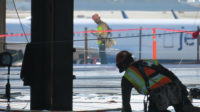Crews are focusing on punch-list items and fiber-reinforced wrapping of bridge columns following a fast-track overpass replacement made possible by long-standing relationships between subcontractors and suppliers and a contracting company’s history of similar feats, according to project team members.
Myers & Sons Construction, the successor company to C.C. Myers, earned an $8-million early-completion bonus in May for replacing an 800-ft-long dual-deck overpass at Highway 101 and Alemany Boulevard in San Francisco. The scheduled 10-day job, completed in eight, had originally been planned for July.
But the pandemic spurred the California Dept. of Transportation (Caltrans) to think about moving the date up to take advantage of drastically reduced traffic on a typically heavily traveled peninsula.
“At one point, the goal was [to start in] the middle of May,” says Bob Finney, Caltrans district construction deputy. “Then we asked, ‘Can you be done by May?’ ”
The contractor had won the low bid in January. “We’d spent the next couple of months thinking about how we were going to build this in July,” says Clinton Myers, vice president of Myers and Sons. “Then they asked if we could get out there in April. We went from a lot of theorizing and strategizing into real planning and execution overnight.”
Caltrans knew that Myers’ staff had a long track record of success with similar incentive-fueled projects, dating back to 1989 and the Loma Prieto earthquake.
“The stars aligned,” says Tony Tavares, Caltrans Bay Area director. “This was not a typical project. It involved city, county, transportation agencies, residents and businesses, local bike groups, even Major League Baseball and concert and convention venues.” Stakeholders included two major hospitals that would be affected by the pandemic during the construction work, he adds. “We took three months of what was typical planning to get it done in July and squeezed it into two weeks.”
Kurtis Frailey, the contractor’s operations manager, says the bumped-up May 4 deadline sent subs and suppliers into high gear. “We didn’t know if regular construction materials were closing down until [the state] defined essential work,” he recalls. “We started gathering materials in anticipation of the pandemic.”
Scott Wilson, the firm’s superintendent, says it worked nonstop for three weeks just to prepare for the 10-day shutdown. Suppliers of lumber for the demolition platform, Nelson studs, rebar, deck drains—and custom overhang jacks from Roadway Steel & Fabrication Inc.—all had to hustle to get deliveries to the site. In one case, the delivery came the night before installation of Rupert Construction Supply’s deck drains. Frailey notes that Martinez Steel had to fabricate various rebar lengths itself.
Myers and Sons relied heavily not only on the hustle of its subs and suppliers but on its own staff from other jobs throughout the country, many of whom have worked together for years, says Frailey.
On April 24, demolition subcontractor Silverado started work on the old overpass. Thus began a choreographed sequence. Myers’ crews followed, forming the deck soffits and adjusting the grade in the girder haunch heights. The haunch variations ranged from 2 in. to 18 in.
Subcontractor Jeffco followed, blasting the girders to remove paint and rust. Next came crews welding some 28,500 Nelson studs, ranging from 4 in. to 9 in. Rebar installers followed using prefabricated stirrups due to the varying haunches. Crews began concrete pours while ironworkers were still completing the rebar.
Finney notes that Caltrans designers came up with an S-curved ramp to reroute northbound 101 traffic to free up space. Due to the pandemic-related reduced traffic, “vehicles were going 100 miles per hour,” he says. “We changed the curve daily, sometimes down to one lane.”
Caltrans worked closely with the team to eliminate red tape, such as letting the deck drains be fabricated without approved shop drawings. “We met daily on work plans, materials, concrete production—we had plenty of inspectors out there, materials, mobile concrete testing plants, even food and water since nothing was open,” says William Casey, Caltrans senior bridge engineer.
Crews are now removing formwork, wrapping columns and painting girders, with eight contractual months remaining.




Post a comment to this article
Report Abusive Comment